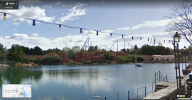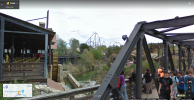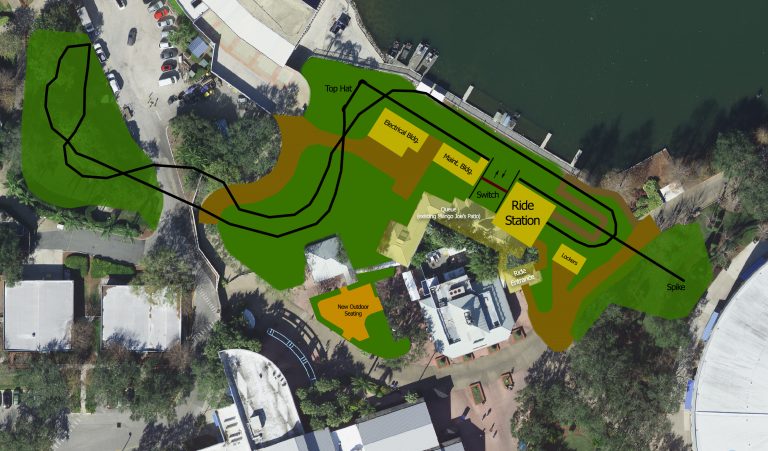Fluorineer
Mega Poster
What are some coaster layouts that truly impress you not necessarily because of the ride experience, but because of the blatant brilliance of the design itself? What makes a brilliant coaster design, and what are some design accomplishments that easily go overlooked or are overshadowed by aspects of the actual ride experience?
A coaster design that will always have a special place in my heart is Goliath at Six Flags Great America
It takes an enourmously ambitious engineer to think of putting in a 50m tall Wooden Coaster into the footprint the ride occupies, considering all Wooden Coasters of similar height are absolute behemoths that take up a good chunk of prime real estate in their respective parks.
I don't think I need to say much about the support structure, it's just incredible. This coaster could easily have looked ridiculous and obstructed by a mountain of wood (just imagine the support structure of the dive loop, except it's everywhere), instead it's both a display of engineering marvel as well as it's prime elements.
Talking about elements, the choice is absoultely perfect. Not a single meter of track is wasted. While a top speed of 115 kph eliminates all pacing problems one could have had entirely, it makes it significantly harder to size the elements appropiately within the tight footprint. It hits the perfect mixture of standard wooden coaster elements like the first drop, tunnels, turnarounds and airtime hill, appropiately turns them up to 11 and combines it with ridiculous inversions never seen on a Wooden Coaster before, which are not only fit accordingly to the ride experience, but also to the ride engineering - the Dive Loop is necessary to avoid a 3rd tight turnaround, and the Zero-G-Stall is the heart and soul of the support structure.
While complaints about the short ride duration are valid, this is a byproduct of the unusually high top speed, and a track length of 945m is nothing to scoff at. Also, I must say that I'm a big fan of RMC's general approach: if there is a way we can make it that high, that steep and that fast, there is no reason we shouldn't. It makes you wonder what other compact (wooden) coasters could have packed significantely more of a punch if the ride designers didn't autopilot towards lower heights just because the footprint is small.
And as a nice cherry on top, the layout is reminiscient of the classic Cyclone layout. It is also not a contraption press fit into the specific circumstances at Great America, but instead easily cloneable. I suppose it is unfortunate that most other Six Flags park had a bad wooden coaster they rather converted than building a new Topper Track, and the Raptor has become more attractive to smaller parks who are looking to plop in a ridiculous and compact thrill coaster, but it's not hard to imagine circumstances in which Goliath-clones plop up all over the US.
tl;dr: Alan Schilke is truly my favourite crackhead
A coaster design that will always have a special place in my heart is Goliath at Six Flags Great America
It takes an enourmously ambitious engineer to think of putting in a 50m tall Wooden Coaster into the footprint the ride occupies, considering all Wooden Coasters of similar height are absolute behemoths that take up a good chunk of prime real estate in their respective parks.
I don't think I need to say much about the support structure, it's just incredible. This coaster could easily have looked ridiculous and obstructed by a mountain of wood (just imagine the support structure of the dive loop, except it's everywhere), instead it's both a display of engineering marvel as well as it's prime elements.
Talking about elements, the choice is absoultely perfect. Not a single meter of track is wasted. While a top speed of 115 kph eliminates all pacing problems one could have had entirely, it makes it significantly harder to size the elements appropiately within the tight footprint. It hits the perfect mixture of standard wooden coaster elements like the first drop, tunnels, turnarounds and airtime hill, appropiately turns them up to 11 and combines it with ridiculous inversions never seen on a Wooden Coaster before, which are not only fit accordingly to the ride experience, but also to the ride engineering - the Dive Loop is necessary to avoid a 3rd tight turnaround, and the Zero-G-Stall is the heart and soul of the support structure.
While complaints about the short ride duration are valid, this is a byproduct of the unusually high top speed, and a track length of 945m is nothing to scoff at. Also, I must say that I'm a big fan of RMC's general approach: if there is a way we can make it that high, that steep and that fast, there is no reason we shouldn't. It makes you wonder what other compact (wooden) coasters could have packed significantely more of a punch if the ride designers didn't autopilot towards lower heights just because the footprint is small.
And as a nice cherry on top, the layout is reminiscient of the classic Cyclone layout. It is also not a contraption press fit into the specific circumstances at Great America, but instead easily cloneable. I suppose it is unfortunate that most other Six Flags park had a bad wooden coaster they rather converted than building a new Topper Track, and the Raptor has become more attractive to smaller parks who are looking to plop in a ridiculous and compact thrill coaster, but it's not hard to imagine circumstances in which Goliath-clones plop up all over the US.
tl;dr: Alan Schilke is truly my favourite crackhead





